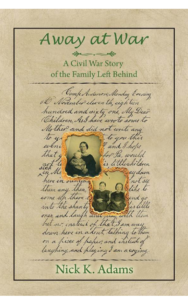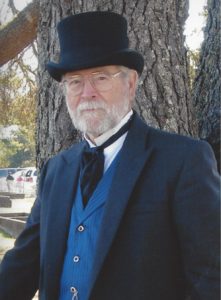Nick Adams on “A Civil War Story of the Family Left Behind”

What was the Civil War like for the families of those who chose to fight?
Nick Adams will be telling one such story in a thematic outline of his new book: Away at War: A Civil War Story of the Family Left Behind. This will be a follow-up to his presentation last year which focused on the 100 letters his great-great-grandfather wrote back from the Western Theater battlefields (My Dear Wife and Children: Civil War Letters from a 2nd Minnesota Volunteer).
He will share with us the terrible impact, the pain and anxiety, and the untold suffering war can cause the families of soldiers. With the winter of 1861 approaching, Minerva Griffin and her three young children are alone on the Minnesota prairie, for the husband and father of the family has left them for the fight to preserve the Union. She is now responsible for preserving both farm and family for his hoped-for eventual return. It is a true tale, developed from his letters home, of the difficult struggle to survive experienced by those left behind.

Nick Adams’s passion for the American Civil War began at the age of nine, when his mother first told him about her great-grandfather, David Brainard Griffin, who had fought with the 2nd Minnesota Regiment of Volunteers, and had been killed at the Battle of Chickamauga. What she didn’t tell him about at that time was the 100 preserved letters he had written back to his young family on the Minnesota prairie … because she didn’t know about them, for they had been passed down in another branch of the family. When they were finally shared with her some forty years ago, she was permitted to make a single copy, which she graciously gave to Nick because she knew of his life-long interest. The originals are presumed no longer to survive, but his copies have been deposited with the Minnesota Historical Society.
Following post-graduate studies in Church History (Abilene Christian) and Sociology of Religion (University of Iowa), Nick spent 30 years in Pastoral Ministry and Social Justice, then returned to teaching, this time at the Elementary School level, and completed 20 years in the classroom. It was during those classroom years that the letters were given to him. By reading his personal account of involvement in the conflict, they became the perfect instrument for creating student interest in the period.
Since retirement, Nick has authored three books about the letters. Last spring he presented to our roundtable his story, as related in the letters (My Dear Wife and Children: Civil War Letters from a 2nd Minnesota Volunteer). This year he will tell his family’s story: Away at War: A Civil War Story of the Family Left Behind.
